by Bruce Wells | Jun 12, 2025 | Petroleum Technology
Founded in 1932, the oilfield service company Lane-Wells developed powerful perforating guns.
Fifteen years after its first oil well perforation job, Lane-Wells Company returned to the same well near Montebello, California, to perform its 100,000th perforation. The publicity event of June 18, 1948, was a return to Union Oil Company’s La Merced No. 17 well.
The gathering of executives at the historic well celebrated a significant leap in petroleum production technology. The combined inventiveness of the two oilfield service companies had accomplished much in a short time, “so it was a colorful ceremony,” reported a trade magazine.

As production technologies evolved after World War II, Lane-Wells developed a downhole gun with explosive energy to cut through well casing. Above, one of the articles preserved in a family scrapbook, courtesy Connie Jones Pillsbury, Atascadero, California.
Officials from both companies and guests gathered to witness the repeat performance of the company’s early perforating technology, noted Petroleum Engineer in its July 1948 issue. Among them were “several well-known oilmen who had also been present on the first occasion.”

Walter Wells, chairman of the board for Lane-Wells, was present for both events. The article reported he was more anxious at the first, which had been an experiment to test his company’s new perforating gun. In 1930, Wells and another enterprising oilfield tool salesman, Bill Lane, developed a practical way of using guns downhole.
The two men envisioned a tool that could shoot steel bullets through casing and into the formation. They would create a multiple-shot perforator that fired bullets individually by electrical detonation. After many test firings, commercial success came at the Union Oil Company La Merced well.
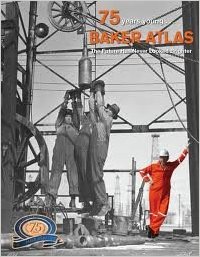
Cover of a special publication featuring the 75th anniversary of Baker Atlas oil well service company. Lane-Wells became part of Baker Atlas, today a division of Baker-Hughes
Founded in Los Angeles in 1932, the oilfield service company Lane-Wells built a fleet of trucks as it became a specialized provider of well perforations — a key service for enhancing well production (see Downhole Bazooka).
The two men designed tools that would better help the oil industry during the Great Depression. “Bill Lane and Walt Wells worked long hours at a time, establishing their perforating gun business,” explained Susan Wells in a 2007 book celebrating the 75th anniversary of Baker-Atlas.
“It was a period of high drilling costs, and the demand for oil was on the rise,” Wells added. “Making this scenario worse was the fact that the cost of oil was relatively low.”
Shotgun Perforator
By late 1935, Lane-Wells recognized high-powered guns were needed for breaking through casing, cement and into oil-bearing rock formations.

An experienced oilfield worker, Sidney Mims, had patented a similar technical tool for this, but he could not get it working as well as it should. Lane and Wells purchased the patent and refined the downhole gun design. Lane-Wells developed a remotely controlled 128-shot perforator — a downhole shotgun.
“Lane and Wells publicly used the re-engineered shotgun perforator they bought from Mims on Union Oil’s oil well La Merced No. 17,” Wells noted. “There wasn’t any production from this oil well until the shotgun perforator was used, but when used, the well produced more oil than ever before.”

Lane-Wells provided perforating services using downhole “bullet guns,” seen here in 1940.
The successful application attracted many other oil companies to Lane-Wells as the company modified the original 128-shot perforator to use 6-shot and 10-shot cylinders. For a public relations event, executives decided to conduct the company’s 100,000th perforation almost 16 years after the first at the La Merced No. 17 well.
Continued success in Oklahoma and Texas oilfields led to new partnerships beginning in the 1950s. A Lane-Wells merger with Dresser Industries was finalized in March 1956, and another corporate merger arrived in 1968 with Pan Geo Atlas Corporation, forming the service industry giant Dresser Atlas.
A 1987 joint venture with Litton Industries led to Western Atlas International, which became an independent company before becoming a division of Baker-Hughes in 1998 (Baker Atlas) providing well logging and perforating services. Dresser merged with Halliburton the same year.
Preserving Oil History
Connie Jones Pillsbury of Atascadero, California, and the family of Walter T. Wells wanted to preserve rare Lane-Wells artifacts. She contacted the American Oil & Gas Historical Society for help finding a home for an original commemorative album, press clippings and guest book from June 18, 1948.

Seeking to preserve the “Lane-Wells 100,000th Gun Perforating Job” event at Montebello, California — site of the Union Oil Company La Merced No. 17 well — Pillsbury and the children of Dale G. Jones, the grandson of Walter T. Wells, contacted petroleum museums, libraries, and archives (also see Oil & Gas Families).
Pillsbury’s quest to preserve the Walter T. Wells album and records proved successful, and she emailed AOGHS to report the family’s album was “safely archived at the USC Libraries Special Collections. Sue Luftschein is the Librarian. It’s on Online Archive of California (OAC).”
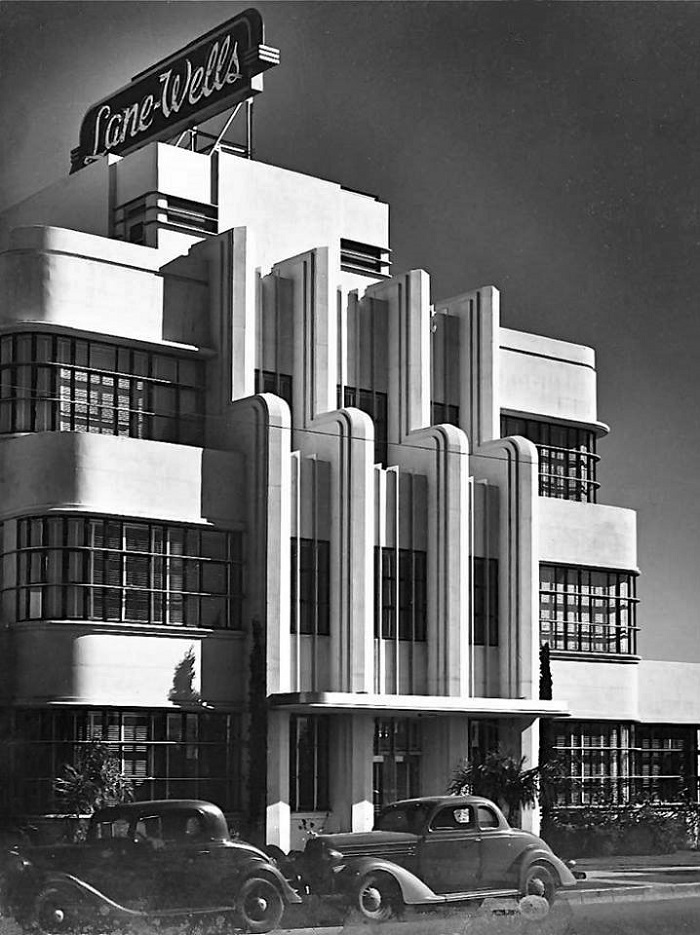
The Lane-Wells West Coast headquarters designed by architect William E. Mayer and completed in 1937 in what became Huntington Park in Los Angeles. Photo courtesy Water and Power Associates.
The Lane-Wells collection — Gift of Connie Pillsbury, October 27, 2017 — can be accessed via the OAC website.
Title: Lane-Wells Company records
Creators: Wells, Walter T. and Lane-Wells Company
Identifier/Call Number: 7055
Physical Description: 1.5 Linear Feet 1 box
Date (inclusive): 1939-1954
The archive abstract also notes:
“This small collection consists of a commemorative album celebrating the 100,000th Gun Perforating Job by the Lane-Wells Company of Los Angeles on June 18, 1948, and additional printed ephemera, 1939-1954, created and collected by Walter T. Wells, co-founder and Chairman of the Board of the Lane-Wells Company.”
Pillsbury sought a museum or archive home for her rare oil patch artifact, which came from an event attended by many from the Los Angeles petroleum industry.
“The professionally-prepared book has all of the attendees signatures, photographs and articles on the event from TIME, The Oil and Gas Journal, Fortnight, Oil Reporter, Drilling, The Petroleum Engineer, Oil, Petroleum World, California Oil World, Lane-Wells Magazine, the L.A. Examiner, L.A. Daily News and L.A. Times, etc.,” Pillsbury noted in 2017.

The 1948 commemorative book, now preserved at USC, “was given to my first husband, Dale G. Jones, Ph.D., grandson of Walter T. Wells, one of the founders of Lane-Wells,” she added. “His children asked me to help find a suitable home for this book. I found you (the AOGHS website) through googling ‘History of Lane-Wells Company.’”
_______________________
Recommended Reading: 75 Years Young…BAKER-ATLAS The Future has Never Looked Brighter (2007); Wireline: A History of the Well Logging and Perforating Business in the Oil Fields
(2007); Wireline: A History of the Well Logging and Perforating Business in the Oil Fields (1990)
(1990) . Your Amazon purchase benefits the American Oil & Gas Historical Society. As an Amazon Associate, AOGHS earns a commission from qualifying purchases.
. Your Amazon purchase benefits the American Oil & Gas Historical Society. As an Amazon Associate, AOGHS earns a commission from qualifying purchases.
_______________________
The American Oil & Gas Historical Society (AOGHS) preserves U.S. petroleum history. Please become an AOGHS annual supporter and help maintain this energy education website and expand historical research. For more information, contact bawells@aoghs.org. © 2025 Bruce A. Wells.
Citation Information – Article Title: “Lane-Wells 100,000th Perforation” Authors: B.A. Wells and K.L. Wells. Website Name: American Oil & Gas Historical Society. URL: https://aoghs.org/technology/oil-well-perforation-company. Last Updated: June 12, 2025. Original Published Date: June 30, 2017.
by Bruce Wells | Apr 14, 2025 | This Week in Petroleum History
April 14, 1865 – Failed Oilman turns Assassin –
After failing to make his fortune in Pennsylvania oilfields, John Wilkes Booth assassinated President Abraham Lincoln in Washington, D.C. Booth had left his acting career a year earlier to drill an oil well in booming Venango County.
In January 1864, Booth visited Franklin, Pennsylvania, where he leased 3.5 acres on a farm, about one mile south of the village of Franklin and on the east side of the Allegheny River. With several partners, including his friends from the stage, Booth formed the Dramatic Oil Company and raised money to drill a well.

John Wilkes Booth made his first trip to the oil boom town of Franklin, Pennsylvania, in January 1864. He purchased a 3.5-acre lease on the Fuller farm (lower left). Circa 1865 photo of Booth by Alexander Gardner, courtesy Library of Congress.
Although the Dramatic Oil Company’s well found oil and began producing about 25 barrels a day, Booth and his partners wanted more and tried “shooting” the well to increase production. When the well was ruined, the failed oilman left the Pennsylvania oil region for good in July 1864.
Learn more in Dramatic Oil Company.
April 14, 1903 – Patent for Self-Heating Iron fueled by Gasoline
John Lake of Big Prairie, Ohio, received a U.S. patent (No. 725,261) for his gasoline-fueled “Self-Heating Sad Iron.” Lake had served in the 16th Ohio Volunteer Infantry Regiment during the Civil War. The ironing innovation for homes brought prosperity to his Amish community, where he established the Monitor Sad Iron Company on the Pennsylvania Railroad line. His manufacturing company made the petroleum-fueled irons for the next 50 years.
Learn more in Ironing with Gasoline.
April 15, 1857 – First Natural Gas Company incorporated
Two years before the first U.S. oil well in Titusville, Pennsylvania, the Fredonia Gas Light and Water Works Company incorporated in Fredonia, New York, where a well drilled by local machinist and gunsmith William A. Hart supplied natural gas to a mill as early as 1825. Hart found the gas after drilling three wells, according to historian Lois Barris.
“He left a broken drill in one shallow hole and abandoned a second site at a depth of forty feet because of the small volume of gas found,” Barris noted in her “Fredonia Gaslight and Waterworks Company.”

Circa 1950 souvenir postcard of a bronze plaque on a boulder in Fredonia, New York, dedicated in 1925 by the Daughters of the American Revolution.
Hart’s third well produced natural gas from 70 feet beneath a “bubbling gas spring in the bed of a creek,” Barris reported, adding that after constructing a simple gasometer, he “proceeded to pipe and market the first natural gas sold in this country.”
As other communities adopted public lighting burning gas made from coal (manufactured gas street lamps began illuminating Baltimore in 1817), Fredonia Gas Light and Water Works built the first U.S. natural gas pipeline network.

April 15, 1897 – Birth of Oklahoma Oil Industry
With a crowd gathered at the Nellie Johnstone No. 1 well near Bartlesville in Indian Territory, George Keeler’s stepdaughter dropped a “Go Devil” that set off a downhole canister of nitroglycerin. The resulting gusher heralded the start of Oklahoma’s oil and natural gas industry.
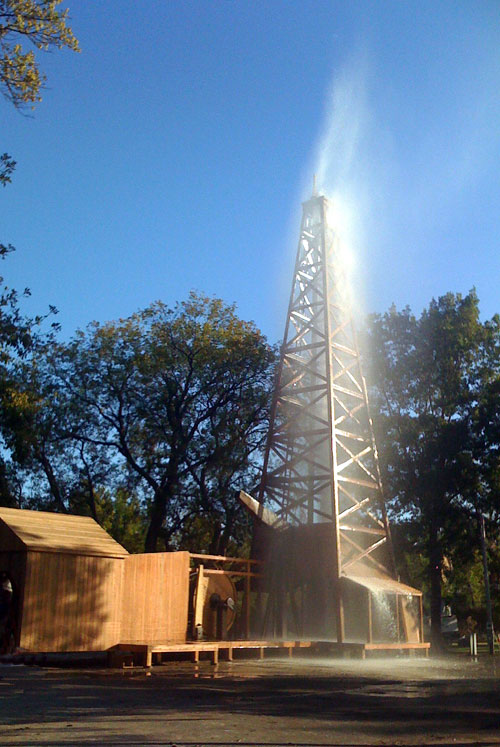
A 2017 water gusher demonstration of the Nellie Johnstone No. 1 replica in Discovery One Park, Bartlesville, Oklahoma.
Drilling had begun in January 1897, the same month that Bartlesville incorporated with a population of about 200 people. Four months later, at 1,320 feet, the Nellie Johnstone No.1 well showed its first signs of oil. There had been earlier marginal producers, including a Cherokee Nation 1890 oil well; the Johnstone well revealed the giant Bartlesville-Dewey field.
By the time of statehood in 1907, Oklahoma would lead the world in oil production. An 84-foot derrick in Discovery One Park helps educate visitors about Oklahoma’s petroleum industry. The surrounding land was donated by Nellie Johnstone Cannon, the descendant of a Delaware chief.
Learn more in First Oklahoma Oil Well.
April 16, 1855 – Scientist sees Value in “Rock Oil”
Yale chemist Benjamin Silliman Jr. reported Pennsylvania “Rock Oil” could be distilled into a high-quality illuminating oil. The professor’s “Report on Rock Oil or Petroleum” convinced a businessman George Bissell and a group of New Haven, Connecticut, investors to finance Edwin Drake to drill where Bissell had found oil seeps at a creek in northwestern Pennsylvania.
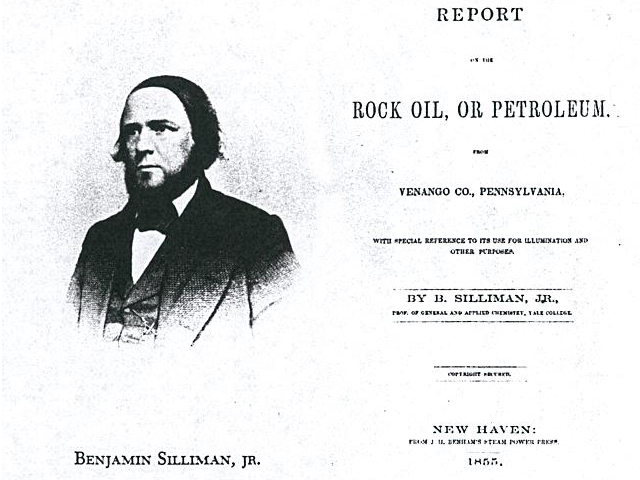
The Yale chemist’s 1855 report about oil’s potential for refining as an illuminant led to America’s first commercial well four years later.
“Gentlemen,” Silliman wrote, “it appears to me that there is much ground for encouragement in the belief that your company have in their possession a raw material from which, by simple and not expensive processes, they may manufacture very valuable products.”
Learn more in George Bissell’s Oil Seeps.
April 16, 1920 – First Arkansas Oil Well
Col. Samuel S. Hunter of the Hunter Oil Company of Shreveport, Louisiana, completed the first oil well in Arkansas. His Hunter No. 1 well had been drilled to 2,100 feet. Natural gas was discovered a few days later by Constantine Oil and Refining Company north of what would become the El Dorado field in Union County.
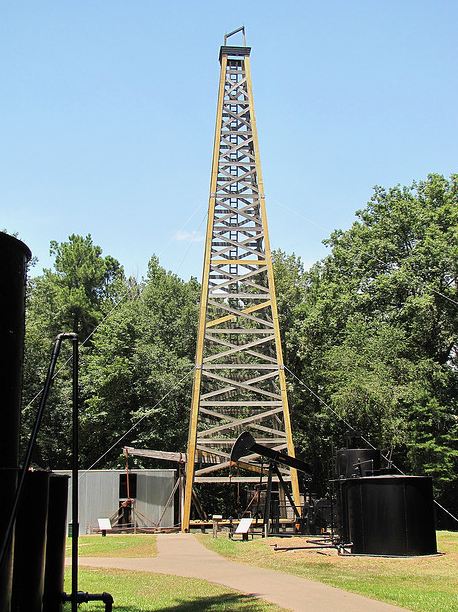
The Arkansas Museum of Natural Resources is just north of El Dorado.
Although Col. Hunter’s oil well yielded only small quantities, his discovery was followed by a January 1921 gusher — the S.T. Busey well — in the same field. These wells made headlines and launched the Arkansas petroleum industry, according to the Arkansas Museum of Natural Resources. Hunter later sold his original lease of 20,000 acres to the Standard Oil Company of Louisiana for more than $2.2 million.
Learn more in First Arkansas Oil Wells.

April 17, 1861 – Deadly Oil Well Fire in Pennsylvania
The lack of technologies for controlling wells led to a fatal oil well fire at Rouseville, Pennsylvania. Among the 19 people killed was leading citizen Henry Rouse, who subleased the land along Oil Creek. When his well erupted oil from a depth of 320 feet, the good news had attracted most Rouseville residents. “Henry Rouse and the others stood by wondering how to control the phenomenon,” noted the local newspaper. Then the gusher erupted into flames, perhaps ignited by a steam-engine boiler.
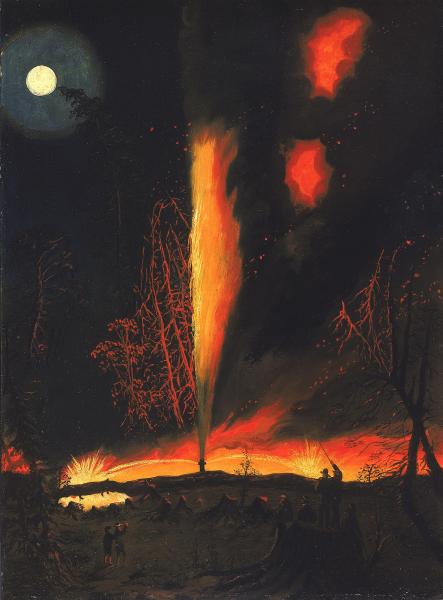
“Burning Oil Well at Night, near Rouseville, Pennsylvania,” a painting by James Hamilton, circa 1861, at the Smithsonian American Art Museum, Washington, D.C.
The oilfield tragedy near Titusville would be overshadowed by the Civil War, but it was immortalized in 1861 by Philadelphia artist James Hamilton’s “Burning Oil Well at Night, near Rouseville, Pennsylvania,” which was added to the Smithsonian American Art Museum collection in 2017.
Learn more in Fatal 1861 Rouseville Oil Well Fire.
April 17, 1919 – North Texas Burkburnett Boom grows
Yet another drilling boom began in Wichita County, Texas, when the Bob Waggoner Well No. 1 well began producing 4,800 barrels of oil a day — extending to the northwest a 1918 oilfield found on the Burkburnett farm of S.L. Fowler. Wichita County had been producing oil since the 1911 discovery of the Electra oilfield.
At Burkburnett, a 2006 historical marker of the Texas Historical Commission notes the 1919 discovery “became known as the Northwest Extension Oilfield, comprised of approximately 27 square miles on the former S. Burk Burnett Wild Horse Ranch.” The marker adds “the area was suddenly thick with oil derricks” thanks to the oilfield discoveries that created the boom town Burkburnett.
April 18, 1939 – Patent for perforating Well Casing
Ira McCullough of Los Angeles patented a multiple bullet-shot casing perforator and mechanical firing system. He explained the object of his oilfield invention was “to provide a device for perforating casing after it has been installed in a well in which projectiles or perforating elements are shot through the casing and into the formation.”
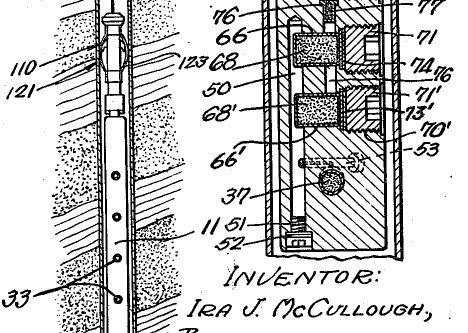
Ira McCullough’s 1937 patent drawing for perforating wells.
The innovation of simultaneous firing from several levels in the borehole greatly enhanced the flow of oil. McCullough’s device included a “disconnectable means” that rendered percussion inoperative until the charges were lowered into the borehole, acting as “a safeguard against accidental or inadvertent operation.”
Another inventor, Henry Mohaupt, in 1951 used anti-tank technology from World War II to improve the concept by using a conically hollowed-out explosive for perforating wells.
Learn more in Downhole Bazooka.
April 19, 1892 – First U.S. Gasoline Powered Automobile
Brothers Charles and Frank Duryea test drove a gasoline-powered automobile they had built in their Springfield, Massachusetts, workshop. Considered the first model to be regularly manufactured for sale in the United States, 13 were produced by the Duryea Motor Wagon Company.

The Duryea brothers (above) built their pioneering autos in Springfield, Massachusetts.
The brothers sold their first Duryea motor wagon in March 1918. Two months later, a motorist driving a Duryea in New York City hit a bicyclist — reportedly America’s first auto traffic accident. By the time of the first U.S. automobile show in November 1900 at Madison Square Garden, of the 4,200 automobiles sold in the United States, gasoline powers less than 1,000.

April 20, 1875 – Improved Well Pumping Technology
Pumping multiple wells with a single steam engine boosted efficiency in early oilfields when Albert Nickerson and Levi Streeter of Venango County, Pennsylvania, patented their “Improvement In Means For Pumping Wells.” The new technology used a system of linked and balanced walking beams to pump oil wells.
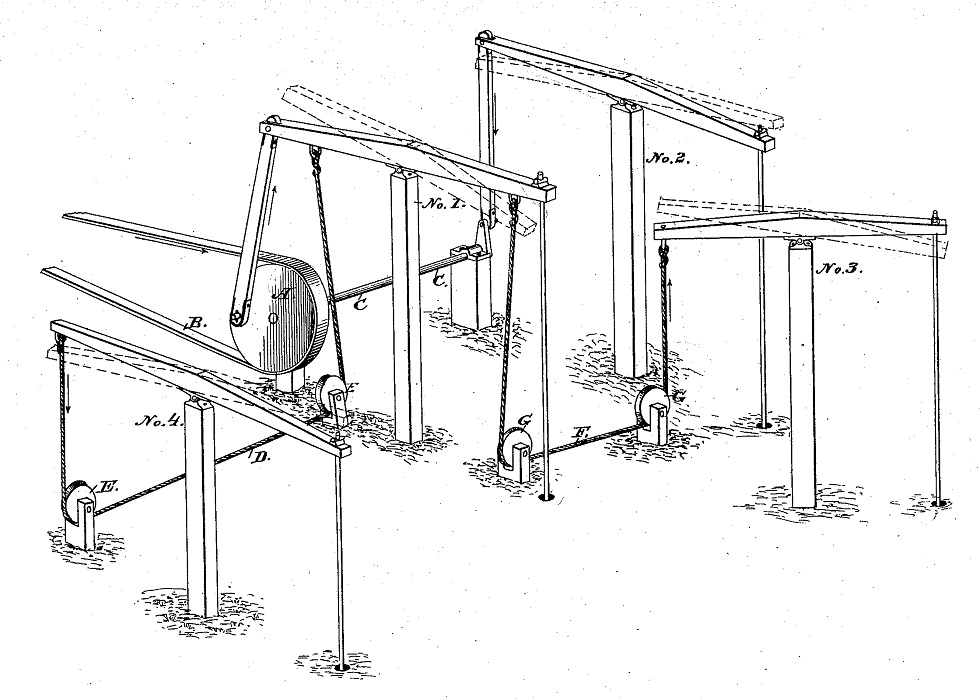
U.S. oilfield technologies advanced in 1875 with an “Improvement In Means For Pumping Wells.”
“By an examination of the drawing it will be seen that the walking-beam to well No. l is lifting or raising fluid from the well. Well No. 3 is also lifting, while at the same time wells 2 and 4 are moving in an opposite direction, or plunging, and vice versa,” the inventors explained. Their system was the forerunner of rod-line (or jerk-line) eccentric wheel systems that operated into the 20th century using iron rods instead of rope and pulleys.
Learn more in All Pumped Up – Oilfield Technology.
April 20, 1892 – Prospector discovers Los Angeles City Oilfield
The giant Los Angeles oilfield was discovered when a struggling prospector, Edward Doheny, and his mining partner Charles Canfield drilled into the tar seeps between Beverly Boulevard and Colton Avenue. Their well produced about 45 barrels of oil a day.
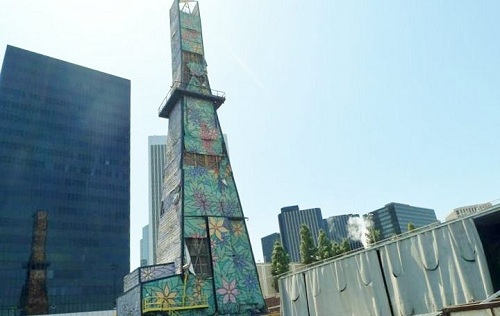
Artfully camouflaged petroleum production continues today in downtown Los Angeles. Edward Doheny discovered the oilfield in 1892. Photo courtesy the Center for Land Use Interpretation, Culver City, California.
Although the first California oil well had been drilled after the Civil War, Doheny’s 1892 discovery near present-day Dodger Stadium launched California’s petroleum industry. In 1897, about 500 Los Angeles City wells pumped more than half of the state’s annual production of 1.2 million barrels of oil. By 1925, California supplied half of all the world’s oil.
Learn more in Discovering Los Angeles Oilfields.
April 20, 2010 – Deepwater Horizon Gulf of Mexico Disaster
At 10 a.m., while completing a well in the Macondo Prospect, 50 miles off the Louisiana coast, the Deepwater Horizon exploded and sank, killing 11 and injuring another 17 workers. An estimated 3.2 million barrels of oil flowed into the Gulf of Mexico after the platform’s 400-ton blowout preventer failed, resulting in the largest accidental marine oil spill in U.S. history.
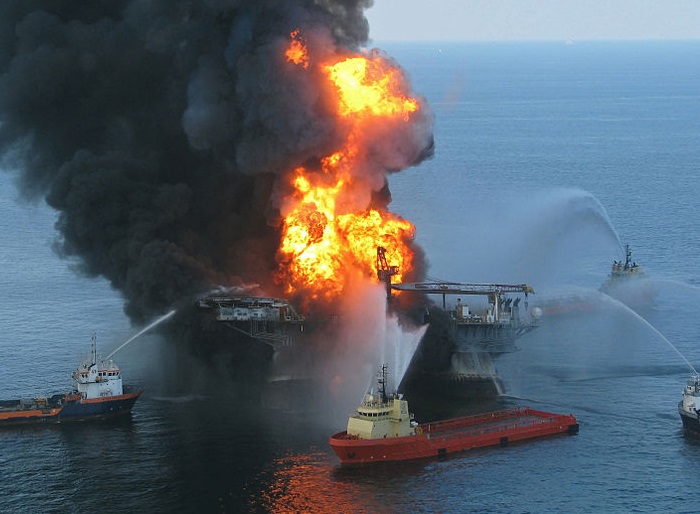
The April 2010 Deepwater Horizon explosion and fire killed 11 and injured 17 workers. USGS Photo.
Six months earlier at another site, the advanced, semi-submersible drilling rig had set a world record for the deepest offshore well (35,050 feet vertical depth in 4,130 feet of water). When the Macondo Prospect well was capped in mid-July, a National Commission on the Deepwater Horizon Oil Spill and Offshore Drilling launched an eight-month investigation. The commission released its final report on January 11, 2011.
_______________________
Recommended Reading: Recommended Reading: Sketches in Crude-Oil (1902); Myth, Legend, Reality: Edwin Laurentine Drake and the Early Oil Industry (2009); The Extraction State, A History of Natural Gas in America (2021); Oil in Oklahoma
(2009); The Extraction State, A History of Natural Gas in America (2021); Oil in Oklahoma (1976); Early Louisiana and Arkansas Oil: A Photographic History, 1901-1946
(1976); Early Louisiana and Arkansas Oil: A Photographic History, 1901-1946 (1982); Cherry Run Valley: Plumer, Pithole, and Oil City, Pennsylvania (2000); Early Texas Oil: A Photographic History, 1866-1936
(1982); Cherry Run Valley: Plumer, Pithole, and Oil City, Pennsylvania (2000); Early Texas Oil: A Photographic History, 1866-1936 (2000); Wireline: A History of the Well Logging and Perforating Business in the Oil Fields
(2000); Wireline: A History of the Well Logging and Perforating Business in the Oil Fields (1990); Dark Side of Fortune: Triumph and Scandal in the Life of Oil Tycoon Edward L. Doheny (2001); Deep Water: The Gulf Oil Disaster and the Future of Offshore Drilling: Report to the President
(1990); Dark Side of Fortune: Triumph and Scandal in the Life of Oil Tycoon Edward L. Doheny (2001); Deep Water: The Gulf Oil Disaster and the Future of Offshore Drilling: Report to the President (2011). Your Amazon purchase benefits the American Oil & Gas Historical Society. As an Amazon Associate, AOGHS earns a commission from qualifying purchases.
(2011). Your Amazon purchase benefits the American Oil & Gas Historical Society. As an Amazon Associate, AOGHS earns a commission from qualifying purchases.
_______________________
The American Oil & Gas Historical Society (AOGHS) preserves U.S. petroleum history. Please become an AOGHS annual supporter and help maintain this energy education website and expand historical research. For more information, contact bawells@aoghs.org. Copyright © 2025 Bruce A. Wells. All rights reserved.



(2007); Wireline: A History of the Well Logging and Perforating Business in the Oil Fields
(1990)
. Your Amazon purchase benefits the American Oil & Gas Historical Society. As an Amazon Associate, AOGHS earns a commission from qualifying purchases.















